What Are Detention Ponds & Why Are They Important?
Detention ponds are used to safeguard the quality of urban water runoff from roads, parking
lots, residential neighborhoods, commercial areas, and industrial sites. Detention ponds
help to reduce peak stormwater runoff rates by providing temporary storage during storm events.
There are two types of detention ponds dry detention ponds and wet detention ponds. As
the name implies dry detention ponds are generally designed to drain completely within 72
hours after a rain event. Wet detention ponds are designed to have a permanent pool of
water during most of, if not all year long.
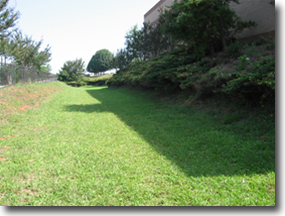
Dry Detention Pond
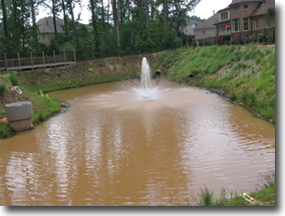
Wet Detention Pond
Additionally a detention pond on your property may provide other benefits such as
passive recreation and open space opportunities while also reducing peak runoff rates
and improving water quality.
Detention ponds are also important because they are a requirement of the stormwater
management program of Greenville County meeting the laws established by the federal Clean
Water Act, administered through the EPA.
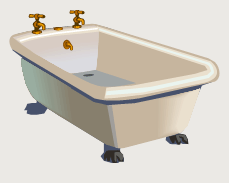
Think of a large bathtub holding all the rainwater than runs off a parking lot
during a storm event. The collected water in a bathtub slowly goes down the drain and the
pollutants, soil, and debris stay in the tub (or pond) rather than rushing down into a
nearby creek or lake. Using the same analogy, think about what is left in a bathtub after it
drains? A visible ring around the tub with the leftover dirt and grim remains. This needs
cleaning out from time to time to keep the bathtub functional.
In the same way, detention ponds allow flood waters to be managed as they slowly enter
the local waterway and the sediment and non point source pollution are kept from entering
the nearby creeks, streams and rivers. Detention ponds also require maintenance to
stay functional.
If You Have A Detention Pond On Your Property Are You Responsible For Maintenance?
Whether you are a member or officer of a Home Owners Association (HOA) or the manager
of a commercial site, you are responsible for assuring that
the detention pond located in your subdivision or on your commercial site is functioning
properly.
The Greenville County Land Development Division will inspect and review maintenance
activities on this detention pond to make sure it is functioning as designed as a part of
the Stormwater Management requirements.
You are responsible for any maintenance or upkeep of this feature. In some instances
this may be a shared responsibility for the correct operation and proper management of
the pond. In the majority of cases, the HOA or commercial property owner are solely responsible
for the correct operation and maintenance of the detention pond.
Maintenance? Why Is It Necessary?
Studies have shown that properly maintained detention ponds are effective at removing
certain pollutants and providing storage for water during rain events to help alleviate
flooding.
Improperly maintained detention ponds may increase the discharge of pollutants downstream. The
risk of flooding in surrounding areas increases when a detention pond is not kept in proper
working condition. This can lead to the instability of channels, aesthetic and nuisance problems.
The bottom line is that detention ponds, also called a Best Management Practice (BMP),
provide (1) a treatment basin for pollutant removal and (2) a collection basin to retain
larger flows thus reducing peak runoff rates downstream.
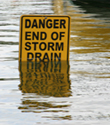
Question: Where does all the water running off of a large commercial parking lot go when a downburst of rain occurs during a summer storm?
Answer: The water safely goes into a properly functioningdetention pond rather than spilling into the roadways and flooding the area making it unsafe for travel.
Why Some Ponds Fail...
Poor maintenance is the leading causes of pond failure. A poorly maintained detention pond
can lead to unpleasant odors, nuisance insects, algae blooms and an unsightly area.
Detention ponds can fail for several reasons such as:
- Poor vegetation maintenance such as out of control weed growth or too little mowing
- Clogged inlets or outlet resulting from trash and debris, and sediment accumulation
- Failed side slopes of the embankment
- Inadequate access to the pond which complicates routine maintenance activities.

Overgrown Vegetation
In A Detention Basin

Trash In Detention Pond
And On A Riser's Trash Rack
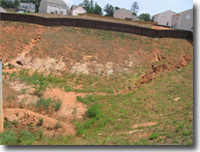
Eroding Banks
In A Detention Pond
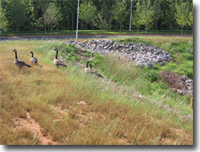
Geese Around
A Detention Pond
What Maintenance Tasks Should Be Considered?
Mowing and debris removal is vital to the proper operation of the detention pond and needs to be done on a ROUTINE basis. Generally this should be done at least semi-annually.
Slope stabilization and sediment removal will probably be done on a NON-ROUTINE basis, such as once a year or as needed.
Every pond is different in size, type, and characteristics of the area that contributes runoff to the pond, as well as the location of the pond within the development.
Refer to the Detention Basin & Maintenance Record to help you lay out a plan for Routine & Non-Routine maintenance tasks.
Operation & Maintenance Program
An effective Operation and Maintenance program requires several things:
- A good plan that specifies what actions are needed, when they will be performed & how often, inspection checklists & follow-up repair timetables
- An understanding of routine & non-routine activities to be employed
- An understanding of the equipment & materials needed for maintenance
- An identification of responsible parties for routine maintenance, non-routine maintenance, inspections and repairs
- Adequate funding for the maintenance repairs.
ROUTINE MAINTENANCE
(4 items) |
NON-ROUTINE MAINTENANCE
(3 items) |
| 1. Inspections - Use the checklist after major rainfall events to check for obstructions and damage and remove debris/trash. |
1. Bank Erosion/Stabilization - It is critical to keep effective ground cover on all vegetated areas in order to see the benefits of proper infiltration of runoff, and effective filtering of pollutants. All areas not vegetated should be re-vegetated and stabilized immediately. |
| 2. Vegetation Management - Mowing on a regular basis. Limited use of fertilizers & pesticides in and around ponds to minimize entry into ponds and subsequent downstream waters. |
2. Sediment Removal - Every year or so, the accumulated sediment depth should be checked. If the depth of the accumulated sediment is greater than 25% of the original design depth or accumulated sediment is blocking inlets or outlets, sediment should be removed. |
| 3. Trash, Debris, & Litter Removal - Removal of any trash causing any obstructions at the inlet, outlet, orifice or trash rack during periodic inspections and especially after rainfall events. Also general pickup of litter in and around the pond during all inspections. |
3. Structural Repair/Replacement - Eventually the outlet structure or other structural components like the emergency spillway or trash rack may need to be repaired or be replaced. |
| 4. Structural Component Check - Inspection of the outlet structure, inlet, orifice, trash rack, emergency spillway on a regular basis for additions to the annual Non-Routine maintenance list. |
|
Vegetation Management As Part Of The Maintenance Of Detention Ponds
A variety of wetland vegetation species that may be growing or that you may plant in your wet detention basin will enhance the overall aesthetic appeal and reduce algae growth.
The creation of a vegetated "no-mow" zone (15' to 25') around a wet detention basin will also help reduce they amount of nutrients such as nitrogen and phosphorus
entering the basin and ultimately reduce algae growth in the pond.
Wildlife Enhancements
Detention ponds that are properly maintained will consist of a healthy, balanced animal community that may include birds, mammals, fish and insects.
Installing bird boxes around basins and stocking fish in wet detention basins are common alternatives for enhancing wildlife and creating balanced ecosystems.
Overpopulation of mosquitoes may occur in detention ponds that are not maintained or functioning properly. Maintain a slight positive slope
on the pond bottom so that the pond will drain properly to the outlet in dry detention ponds. In wet detention ponds install an aerator to prevent the water from becoming stagnant.
The presence of birds and fish in wet ponds can also help to control the mosquito population.
Canada geese have experienced huge population increases throughout the state and are commonly attracted to lawns that are mowed, fertilized, and regularly watered.
Do not feed the geese as this will attract an even larger flock to your site. Goose droppings will increase the levels of fecal coliform in the detention pond.
Specific Activities That Can Enhance The Pond's Operation And Minimize Long-Term Maintenance
 Do not use pesticides, herbicides, or fertilizers in your pond
Do not use pesticides, herbicides, or fertilizers in your pond
 Do not place yard waste such as leaves, grass clippings or brush in the detention pond or in the storm drains located in the streets
Do not place yard waste such as leaves, grass clippings or brush in the detention pond or in the storm drains located in the streets
 Do not dump any materials in the storm sewer system
Do not dump any materials in the storm sewer system
 If you must use fertilizers, only use low-phosphorus, slow-release varieties
If you must use fertilizers, only use low-phosphorus, slow-release varieties
 Pick up and dispose of pet waste with your weekly garbage
Pick up and dispose of pet waste with your weekly garbage
 Provide educational updates to adjoining property owners in neighborhood newsletters or annual meetings
Provide educational updates to adjoining property owners in neighborhood newsletters or annual meetings
Costs & Funding
 The property owner or the Home Owners Association will need to establish an Operating & Maintenance
fund and assess annual fees to cover the costs of upkeep of the detention pond. Typically, fees
are established by the developer prior turning the responsibility of the pond over to the owners(s). After
several years of operation with these set fees, it may be necessary to re-evaluate the maintenance
costs for the actual operation of the pond to keep up with inflation.
The property owner or the Home Owners Association will need to establish an Operating & Maintenance
fund and assess annual fees to cover the costs of upkeep of the detention pond. Typically, fees
are established by the developer prior turning the responsibility of the pond over to the owners(s). After
several years of operation with these set fees, it may be necessary to re-evaluate the maintenance
costs for the actual operation of the pond to keep up with inflation.
Definitions
Dry Detention Pond - A pond designed to temporarily detain stormwater runoff and to release it over a period of time, generally no more than 72 hours; designed to
NOT have a significant permanent pool of water
Emergency Spillway - Conveyance feature of a detention pond to discharge excess stormwater flows to maintain the integrity of the pond structure during substantial runoff events.
Orifice - A controlled opening on the outlet structure through which stormwater is discharged from the pond.
Outlet - A structure that controls the rate of release from the pond, the water depth in the pond, and storage volume of the pond.
Regional Pond - A pond designed to capture stormwater runoff from a large regional area.
Rip Rap - Rock material, generally larger than 4" in diameter, typically used to stabilize channels that convey stormwater.
Riser - A vertical pipe which can function as the outlet structure of a pond. One or more openings are located in the riser to control the flow out of a pond.
Trash Rack - A structural feature of the outlet that prevents large trash and debris from clogging or blocking the outlet.
Water Quality Pond - A detention pond with an orifice sized to allow time for settling and filtering of pollutants before the runoff is discharged from the pond.
Wet Detention Pond - A pond designed to have a permanent pool of water after a storm event.
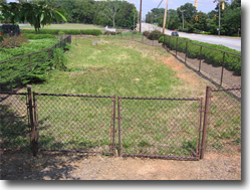
Dry Detention Pond
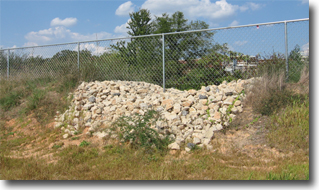
Emergency Spillway

Outlet
Related Links